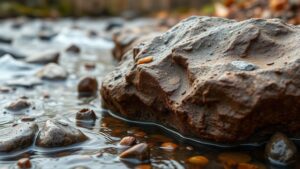Spotting Ancient Sediment Deposits Along Canyon Walls for Silver Recovery
Spotting Ancient Sediment Deposits Along Canyon Walls for Silver Recovery
The allure of silver recovery from ancient sediment deposits has captured the interest of geologists, miners, and treasure hunters alike. Canyons often serve as natural archives of Earths geological history, preserving layers of sediments that can host valuable minerals including silver. This article aims to provide an in-depth exploration of how to effectively spot these ancient deposits in canyon walls, the processes that led to their formation, and the potential recovery methods for silver extraction.
The Geological Context of Canyons
Understanding the formation of canyons is crucial in identifying potential silver deposits. Canyons are typically formed through erosion by water, glaciers, or tectonic activities. Over time, these processes carve deep into the Earth, exposing layers of sedimentary rock that can include ores containing silver.
- Water Erosion: Streams and rivers can create canyons by continuously cutting through rock layers, leaving sedimentary deposits in their wake.
- Glacial Activity: Glaciers transport and deposit materials over vast areas, revealing ancient sediments as they retreat.
In both cases, the types of sediment layers exposed can vary significantly. Identifying the characteristics of these layers aids in understanding where silver may be found.
Identifying Potential Silver Deposits
Spotting ancient sediment deposits that may contain silver requires an eye for detail and an understanding of geological indicators. Typically, silver is found in association with certain minerals such as galena (lead sulfide) or argentite (silver sulfide). Here are key indicators to consider:
- Mineral Composition: Look for signs of galena or argentite within sedimentary layers.
- Layering Patterns: Distinct layers of sediment can signal changes in deposition environments where minerals tend to concentrate.
- Oxidation Staining: The presence of oxidation stains, often reddish or yellow, can indicate mineral concentration areas.
Field observations can be supplemented with geological surveys and mapping to pinpoint promising areas for further exploration.
Case Studies in Silver Recovery
Several case studies highlight successful silver recovery from ancient sediments. For example, the Comstock Lode in Nevada is a historic silver deposit associated with ancient riverbed sediments. Hydrothermal processes deposited silver along with lead and gold. Miners extracted more than 8 million ounces of silver from this location during its peak.
In another example, the mining sites in the Andes create an intriguing environment for recovery. The ancient sediments in this region have revealed deposits rich in silver due to volcanic activity and sedimentary processes. Miners utilize both traditional panning techniques and modern extraction methods for effective recovery.
Modern Recovery Techniques
Once potential silver-bearing sediments have been identified, various recovery techniques can be employed. Each method varies in efficiency and environmental impact:
- Panning: A traditional method ideal for smaller operations, where sediment is washed in shallow pans to separate heavier silver minerals.
- Gravity Separation: Modern techniques rely on gravity concentration methods that exploit differences in mineral densities.
- Cyanidation: This chemical method involves using cyanide to leach silver from ore, but it requires careful environmental management to mitigate risks.
Assessing the most suitable method depends on the scale of operation and the specific environmental conditions of the recovery site.
Environmental Considerations
Recovering silver from ancient sediment deposits must be balanced with environmental responsibility. Minimizing erosion, managing chemical use, and preserving local ecosystems are crucial to sustainable mining practices. Establishing environmental impact assessments prior to commencing recovery operations is a best practice within the industry.
Conclusion
Spotting ancient sediment deposits along canyon walls for silver recovery is both an art and a science, requiring a thorough understanding of geological processes and mineral identification. By applying knowledge of sedimentary layers and utilizing modern recovery methods, miners can effectively extract silver while maintaining a commitment to environmental stewardship.
As interest in mineral recovery continues, it is essential to stay informed on innovative techniques and sustainable practices within the industry. By integrating these approaches, enthusiasts and professionals alike can minimize ecological footprints while maximizing resource recovery.



